
Anisotropic Mesh Adaptation for Phase Field-based Topology Optimisation
Please login to view abstract download link
State-of-the-art topology optimisation approaches are known to suffer from a variety of practical and numerical issues. On the one hand, the homogenisation method requires the introduction of sophisticated de-homogenisation steps to achieve manufacturable structures [1]. On the other hand, the stability of density-based algorithms such as the solid isotropic material with penalisation (SIMP) is known to be extremely sensitive to mesh quality [2], while level-set methods require stable, non-oscillatory schemes to handle the resulting nonlinear Hamilton-Jacobi equation [3].
The phase field method allows to circumvent the difficulties mentioned above by (i) introducing a smoothed description of the boundary of the structure via a diffuse interface approach; (ii) driving its evolution using a reaction-diffusion equation; (iii) employing a double-well potential to achieve a manufacturable structure. Nonetheless, the quality of the resulting optimal structure is affected by the underlying mesh, when a finite element approximation is considered [4].
In this talk, the phase field-based topology optimisation strategy sketched above is enhanced by means of a fourth step performing anisotropic mesh adaptation. Starting from the finite element approximation of the phase field variable, a recovery-based error estimate is constructed, and a metric accounting for the proper orientation, shaping, and sizing of the elements is used to generate an adapted anisotropic mesh.
Numerical experiments will be presented to showcase the ability of the method to achieve manufacturable structures with an accurate description of the boundaries, while significantly reducing the required number of degrees of freedom in the discretisation.

